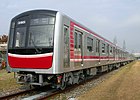Osaka Municipal Subway 20 series
| Osaka Municipal Subway 20 series | |
|---|---|
 A 20 series trainset on the Kintetsu Keihanna Line in December 2023 | |
| In service | 1984–March 2024 |
| Manufacturer | Hitachi, Kawasaki Heavy Industries, Kinki Sharyo, Tokyu Car Corporation |
| Constructed | 1984–1989 |
| Entered service | 24 December 1984 |
| Refurbished | 2004–2006 |
| Number built | 96 vehicles (16 sets)[1] |
| Number in service | None |
| Formation | 6 cars per trainset |
| Fleet numbers | 2601–2607, 2631–2639[2] |
| Operators | Osaka Municipal Transportation Bureau (1984–2018) Osaka Metro (2018–2024) |
| Depots | Dainichi, Morinomiya, Yao |
| Lines served | |
| Specifications | |
| Car body construction | Aluminium alloy |
| Car length | 18.9 m (62 ft 0 in) (end cars) 18.7 m (61 ft 4 in) (intermediate cars) |
| Width | 2.89 m (9 ft 6 in) (end cars) 2.88 m (9 ft 5 in) (intermediate cars) |
| Height | 3,745 mm (12 ft 3 in) |
| Doors | 4 pairs per side |
| Maximum speed | 95 km/h (59 mph) |
| Traction system | GTO–VVVF (as built)[1] IGBT–VVVF (after refurbishment) |
| Acceleration | 3 km/(h⋅s) (1.9 mph/s) |
| Deceleration | 3.5 km/(h⋅s) (2.2 mph/s) 4.5 km/(h⋅s) (2.8 mph/s) (emergency) |
| Electric system(s) | 750 V DC |
| Current collector(s) | Third rail contact shoes |
| Safety system(s) | WS-ATC |
| Track gauge | 1,435 mm (4 ft 8+1⁄2 in) |
The Osaka Municipal Subway 20 series (大阪市交通局20系) was a rapid transit electric multiple unit (EMU) train type operated by Osaka Municipal Subway (now Osaka Metro) in Japan between 1984 and 2024.
Design
[edit]The trains have aluminium bodies.[2] The 20 series was the first Japanese subway train type powered by a third rail to use variable-frequency drive (VVVF) technology from new (and the third overall, after HKL Class M100 and Kumamoto City Transportation Bureau 8200 series).[3] They were also the first trains on the Chuo and Tanimachi lines to include air-conditioning from new.[4]
History
[edit]The first set, 2601, was built on 25 March 1984, entering revenue service on the Chuo Line on 24 December of the same year.[2] Four additional sets were built in 1985 to complement the opening of the Chuo Line extension to Nagata.[1] In 1989, eleven more sets were built of which nine of them were allocated to the Tanimachi Line.[1]
From 2004, in preparation for the opening of the Keihanna Line extension to Gakken Nara-Tomigaoka in 2006, all 20 series sets were retrofitted with IGBT-based traction control systems and the maximum speed of all trains was increased from 70 km/h (43 mph) to 95 km/h (59 mph).[1] In addition, all Tanimachi Line sets were transferred to the Chuo Line in March 2006 in exchange for nine 24 series sets which were redeployed on the Tanimachi Line.[2]
Withdrawal
[edit]Retirement of the 20 series fleet began in 2014 with the first set being removed from service on 21 August.[5] It was replaced by a 24 series set that was transferred from the Yotsubashi Line.[6] With the introduction of new 30000A series and 400 series EMUs, withdrawals of 20 series sets continued in August 2022.[2] The last run took place on 20 March 2024.[7]
Gallery
[edit]-
Interior of a 20 series car
-
Priority seating of a 20 series car
References
[edit]- ^ a b c d e "大阪メトロ中央線「20系」は何が特別だったのか" [What was so special about the Osaka Metro Chuo Line "20 Series"?]. Toyo Keizai Online (in Japanese). Japan. 20 March 2024. Retrieved 6 September 2024.
- ^ a b c d e "残りわずか3本!3月で引退する地下鉄初のVVVF車 大阪メトロ(旧:大阪市営地下鉄)中央線20系(清水要)" [Only 3 left! The first VVVF subway car, Osaka Metro (formerly Osaka Municipal Subway) Chuo Line 20 Series, to be retired in March]. Yahoo News (in Japanese). 4 January 2024. Retrieved 6 September 2024.
- ^ "残り4編成!中央線の旧型車両が2024年3月終焉へ 最後に驚愕のイベントも" [Only 4 trains left! Old model trains on the Chuo Line to be phased out in March 2024, with a surprising event at the end]. Traffic News (in Japanese). Japan: Mediavague Co., Ltd. 30 November 2023. Retrieved 5 September 2024.
- ^ "大阪市交通局 現有車両プロフィール" [Osaka Municipal Transportation Bureau current vehicle profile]. Railroad Pictorial (in Japanese). 744 (March 2004 Special Issue). Japan: Electric Vehicle Research Group: 164. 2004.
- ^ "『保存車両特別公開 in 森之宮検車場』開催" [“Special exhibition of preserved vehicles at Morinomiya Inspection Depot” held]. Japan Railfan Magazine Online (in Japanese). Japan: Koyusha Co., Ltd. 25 August 2014. Retrieved 6 September 2024.
- ^ "大阪市交24系24656編成が試運転" [Osaka Municipal Subway 24 series set 24656 undergoes test run]. Japan Railfan Magazine Online (in Japanese). Japan: Koyusha Co., Ltd. 4 October 2014. Retrieved 6 September 2024.
- ^ "「大阪メトロ」中央線20系、2024年3月引退 - さよならイベント開催" [Osaka Metro Chuo Line 20 Series to retire in March 2024 - Farewell event to be held]. Mynavi News (in Japanese). Japan: Mynavi Corporation. 28 November 2023. Retrieved 6 September 2024.



